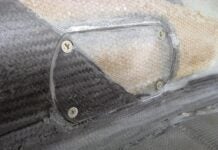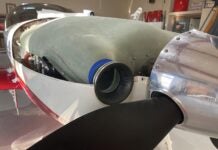The Van’s RV line of aircraft is, without a doubt, the most popular kit aircraft of the century (so far). One of its selling points, to those a bit cynical, is that it isn’t made of “plastic.” Now, I know, I know…that’s somewhat biased, and yes, I believe there are some really cool composite airplanes out there. And just as a composite builder hates the idea of setting 15,000 rivets, a metal builder looks with trepidation at all that glass and resin. But you want to know a little secret? There is no escaping either, no matter what you build. There are plenty of metal parts in a Pulsar, and if I look at my build log for a couple of RVs, I can tell you that the metal builder better be ready for a couple hundred hours of “the messy stuff.”
It might even be double that number, as in the case of the RV-3 that we recently completed. Once we reached the finishing stage of the kit, we seemed to be surrounded by fiberglass. In just a few weeks, we built an empennage fairing, two cowl-cheek extensions and a canopy skirt—all from raw fiberglass materials. “Why?” you may ask. “Why are you building those things from scratch? All of the other Van’s kits come with all of the pieces you need!” Ahh, Grasshopper…the RV-3 is different.

The first step in building up the skirt is to use aluminum, cardboard, clay and tape to mock up the shape that you need. Fiberglass resin will not adhere to vinyl tape, making it an excellent “final finish” to your mold.
The plans and kit for the RV-3 assume that you are pretty good at making compound curves in aluminum sheet and making things fit in a world where nothing is pre-punched and no two airplanes are identical. The cowl-cheek extensions are provided as two triangular pieces of sheet metal with a slight curve and a pair of formed bulkheads that fit about as well as the fuselage bulkheads (which means moderately well). The canopy-skirt parts are also aluminum, obviously rough-worked on a stretcher of some kind to give a little bit of a bubble shape, but the curve is dependent on the shape of both the fuselage and the canopy, and no two of those are really alike. So they are sort of nonstarters as well. The fiberglass empennage fairing is nicely done in a gel-coated way, but, again, the fit leaves something to be desired because so much depends on how you built the tail feathers. The net result is that it is far easier to learn a little fiberglassing and build new parts from scratch than it is to try and beat these things into submission. At least the kit provides you with raw parts on which to build forms and molds!

Modeling clay is available at art-supply houses, and it can be used to form fillets and transitions. Cover it with tape before glassing.
The canopy skirt is a good example. Once we had the turtledeck riveted on, the skin finished with screws, and the canopy bubble and frame installed, it was time to build up a male “mold” for the skirt. We followed the lead of several prominent and recent RV-3B builders and referred to their pictures quite a bit. I used the supplied skirt material to close out the big rectangular holes on each side of the canopy frame, cutting off what I didn’t need. I used 3/32-inch countersunk pop rivets in a few places for temporary attachment. The plan was to use lots of clay to form the necessary fillets between the canopy, skirt and fuselage, but I was quite surprised at how little it actually took. I think we used about five sticks of non-hardening modeling clay (about the size of a stick of butter) for all that we needed. I actually found that aluminum tape worked well to build fillets: Cut it into short segments to allow for compound curves. The only large area that needed to be built up was a mismatch between the port rear side of the canopy frame and the turtledeck, and, again, this was filled in with clay over aluminum tape.

The “finished” mold, fully taped up and ready to be waxed before laying on the fiberglass.
The clay didn’t really need to be smoothed to the mirror-finish that I expected—uniform streaks in the direction of the airflow seemed to be fine, as we covered the entire mold with 2-inch electrician’s vinyl “bundling tape” before fiberglassing. This creates compound curves much better than clear mailing tape, and it is not as prone to wrinkles. You can also do a little smoothing of the clay underneath once it has been applied. The tape doesn’t really stick to the oily clay, but it sticks fine to itself, so start where you have clean aluminum, then use a generous overlap. It really helped during the layup process to draw the expected final outline of the skirt on the tape, both for the bottom edge and on the bubble—that way, we knew that we had sufficient material where we wanted it. We used an old can of Turtle Wax, spread liberally on the tape, as further mold-release.

After laying up the glass and resin, cover the wet layup with strips of Dacron peel-ply to absorb excess resin and leave a smooth surface.
We didn’t take any pictures of the layup process itself, because for two “rookie” composite folks, it was intense enough that we didn’t have time to pick up the camera. In retrospect, we had time, we just didn’t want to embed the camera in resin. We used four plies of 8.9-ounce bidirectional (BID) cloth from Aircraft Spruce to make the layup, layering the four plies on the table and wetting it out that way between layers of 4mm plastic sheeting. We basically made a single layup for each side, a series of strips for the front and rear quarters, and a continuously curving piece for the rear. We used West System’s resin with slow hardener, and in the Houston summer, it was set up firm in about 4 hours—but we gave it overnight before touching it. There is a significant difference between “firm” and “rock hard.” Don’t sand until it is “rock hard.” And watch out for those splinters—wear gloves, or you’ll be donating lots of blood to the project.

Once the resin is cured, the layup should pop right off if you have waxed the vinyl tape. Shooting a little compressed air under an edge will help with the release.
Once the piece was hard, we pried it off pretty easily and began trimming. We could see our previous markings through the layup and traced these with Sharpies to give us a guide. The cut-off wheel and 90º sanding disks made quick work of the excess, and then it was on to final fit. Four Clecoes (two per side) picked up pre-drilled holes in the canopy and canopy form—those anchored the position so that we could drill holes for the latch shaft and mounting screws. And with that, it was ready for endless filling and finishing. It’s good to have the actual structure complete, and the truth is, it only took about four 3-hour work sessions from start to finish. It is about as artistic as it gets in RV construction—it helps to picture where the air molecules are going to go as they find their way around the airplane.
Building the empennage fairing was really not much harder than it would have been to simply make the Van’s-supplied part fit—forming up the mold took a couple of hours, and laying the glass took less—but finishing the part (filling and sanding) was a bit more tedious, mostly because of the tight compound curves. Getting sanding devices into the inside curves takes some patience, but it pays off when the part is finished. Fortunately, as I tell my metal-working friends, composites have one major advantage over aluminum: If you take too much off, you can always add it back on!

Here is the basic layup, trimmed to the desired shape. Getting to this point is a few days’ work. Filling and sanding can take considerably longer!
The cowl-cheek extensions we wanted to build were again copied from (the few) other modern RV-3B builders. One had formed his up using the Van’s parts as a female mold; the other had used pink foam insulation to build up blocks, then carved them to shape and laid the glass over them. I found a very simple method of doing this: I told my spouse/building partner to go make some foam blocks, shape them, finish them with clay, tape them up and make some fiberglass—simplest thing in the world!
Now the truth is, every building technique, be it metal, glass, wood or fabric, has a myriad of detailed lessons that need to be learned. There are thousands of tips that you can read up on and many little “Oh yeah, if you do it this way, you can save a lot of time” things that you can only learn by doing. Personally, I find pictures of the process to be marvelously informing; getting an idea of the “big picture” first gives me a road map to follow. I am constantly amazed by the flexibility afforded by the composite build process—the shapes that can be made and the beauty of a piece molded exactly to its mating part. The shapes fit so well together because they are made to fit each other. I wish I had 30 years of experience with an English wheel to make those beautiful metal cowls for radial engines, but I don’t. So when it comes time to build a nice transition fairing for my RV, I will generally turn to the modern composites. The air molecules are much more friendly when they are least disturbed.














I thought working with fiberglass on my RV8 was fun, until in a moment of carelessness, I accidentally punctured my thumb with a long shard of cure fiberglass while sanding a skirt layup. That required an outpatient surgery to remove a 3/4 inch long shard from the finger. In today’s heavy drug prohibition, codeine could not be prescribed to ease the post surgery pain. Let hope the heavy handed regulators don’t come for the EAB community.